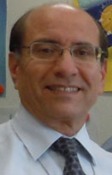Program Information
Developments in International Medical Physics Collaborations in Africa and Latin America

A Shulman
S Guzman
C Borras
A Meghzifene
Y Pipman
A Shulman1*, S Guzman2*, C Borras3*, A Meghzifene4*, Y Pipman5*, (1) (2) (3) ,Washington, DC, (4) International Atomic Energy Agency, Vienna, ,(5) ,Forest Hills, NY
Presentations
WE-AB-213-0 (Wednesday, July 15, 2015) 7:30 AM - 9:30 AM Room: 213
AAPM projects and collaborations in Africa
Adam Shulman (AA-SC Chair)
The African Affairs Subcommittee (AA-SC) of the AAPM will present a multi-institutional approach to medical physics support in Africa. Current work to increase the quality of care and level of safety for the medical physics practice in Senegal, Ghana, and Zimbabwe will be presented, along with preliminary projects in Nigeria and Botswana.
Because the task of addressing the needs of medical physics in countries across Africa is larger than one entity can accomplish on its own, the AA-SC has taken the approach of joining forces with multiple organizations such as Radiating Hope and TreatSafely (NGO’s), the IAEA, companies like BrainLab, Varian and Elekta, medical volunteers and academic institutions such as NYU and Washington University.
Elements of current projects include: 1) Distance training and evaluation of the quality of contouring and treatment planning, teaching treatment planning and other subjects, and troubleshooting using modern telecommunications technology in Senegal, Ghana, and Zimbabwe; 2) Assistance in the transition from 2D to 3D in Senegal and Zimbabwe; 3) Assistance in the transition from 3D to IMRT using in-house compensators in Senegal; 4) Modernizing the cancer center in Senegal and increasing safety and; 5) Training on on 3D techniques in Ghana; 6) Assisting a teaching and training radiation oncology center to be built in Zimbabwe; 7) Working with the ISEP Program in Sub-Saharan Africa; 8) Creating instructional videos on linac commissioning; 9) Working on a possible collaboration to train physicists in Nigeria.
Building on past achievements, the subcommittee seeks to make a larger impact on the continent, as the number and size of projects increases and more human resources become available.
The State of Medical Physics Collaborations and Projects in Latin America
Sandra Guzman (Peru)
The lack of Medical Physicists (MP) in many Latin American (LA) countries leads to recruitment of professionals with incomplete education. In most LA countries only one MP responsible for each Center is currently mandated. Currently there is a large disparity among MP training programs and there is significant debate about the standards of MP graduate education in many LA countries. There are no commonly recognized academic programs, not enough clinical training sites and clinical training is not typically considered as part of the MP work. Economic pressures and high workloads also impede the creation of more training centers. The increasing need of qualified MPs require establishing a coordinated system of national Education & Training Centers (ETC), to meet the international standards of education and training in Medical Physics. This shortfall calls for support of organizations such as the IOMP, AAPM, ALFIM, IAEA, etc. Examples from various LA countries, as well as some proposed solutions, will be presented. In particular, we will discuss the resources that the AAPM and its members can offer to support regional programs.
The 'Medical Imaging' physicist in the emerging world: Challenges and opportunities -
Caridad Borrás (WGNIMP Chair)
While the role of radiation therapy physicists in the emerging world is reasonably well established, the role of medical imaging physicists is not. The only perceived needs in radiology departments are equipment quality control and radiation protection, tasks that can be done by a technologist or a service engineer. To change the situation, the International Basic Safety Standard, which is adopted/adapted world-wide as national radiation protection regulations, states: “For diagnostic radiological procedures and image guided interventional procedures, the requirements of these Standards for medical imaging, calibration, dosimetry and quality assurance, including the acceptance and commissioning of medical radiological equipment, are fulfilled by or under the oversight of, or with the documented advice of a medical physicist, whose degree of involvement is determined by the complexity of the radiological procedures and the associated radiation risks”. Details on how these requirements can be carried out in resource-limited settings will be described.
IAEA support to medical physics in Africa and Latin America: achievements and challenges
Ahmed Meghzifene (IAEA)
Shortage of clinically qualified medical physicists in radiotherapy and imaging, insufficient and inadequate education and training programs, as well as a lack of professional recognition were identified as the main issues to be addressed by the IAEA. The IAEA developed a series of integrated projects aiming specifically at promoting the essential role of medical physicists in health care, developing harmonized guidelines on dosimetry and quality assurance, and supporting education and clinical training programs. The unique feature of the IAEA approach is support it provides for implementation of guidelines and education programs in Member States through its technical cooperation project. The presentation will summarize IAEA support to Latin America and Africa in the field of medical physics and will highlight how the new International Basic Safety Standards are expected to impact the medical physics practice in low and middle income countries.
Learning Objectives:
1. Learn about the shortage of qualified Medical Physicists in Africa and Latin America.
2. Understand the reasons of this shortage.
3. Learn about the ways to improve the situation and AAPM role in this process.
Contact Email:





